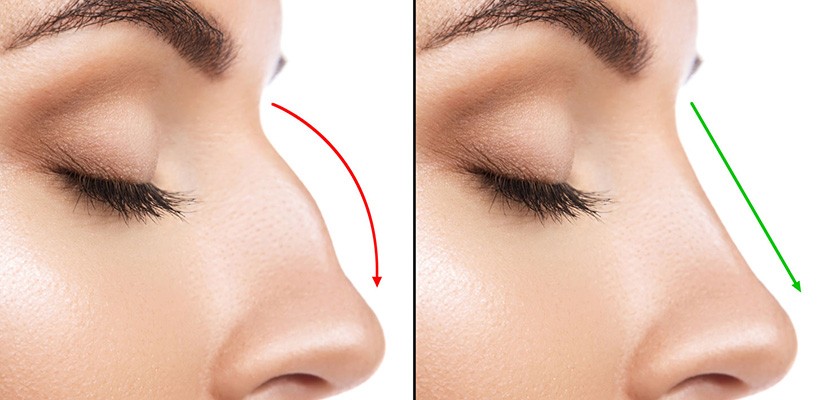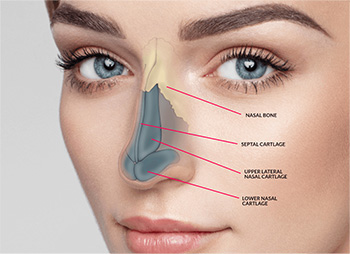
Rhinoplasty
Rhinoplasty is the most commonly performed plastic surgery for both men and women today. It is appropriate to perform it after the age of 18, when the development of the bone structure is largely completed. It is a procedure that can be performed at any time in later years, unless the person has a health condition that prevents surgery.
Nose surgery is a procedure that must be considered individually and calculated in harmony with all parts of our face. The structure of the person's areas such as forehead, chin, and cheekbones should be taken into account and the face should be considered as a whole. Creating a beautiful nose through surgery does not always achieve the desired result and does not create a beautiful face. Unfortunately, images drawn on computers do not always reflect real practice or cannot be performed in surgery performed digitally.
The reason that brings the person (patient) to the doctor may not only be the appearance of the nose, but also deviation (bone curvature) and turbinate hypertrophy (large size of the soft structures inside the nose), which cause breathing problems in the nose. Although the main causes of nasal deformity may be accidents, falls, and impacts, the shape of the nose is mostly structural and the patients do not have any accident-like events in their history.
When planning nose surgery, both functional and aesthetic (cosmetic) purposes should be considered, that is, breathing problems should be eliminated and the nose shape should be made desired. By eliminating these two problems with one surgery, the person is prevented from having separate surgeries and loss of workforce is prevented. By ensuring nasal breathing, the patient's mouth breathing is eliminated, if there is a snoring problem, it is usually resolved and septum deviation, one of the main causes of sinusitis, is eliminated.
The facial structure of the person considering rhinoplasty should first be evaluated. The characteristics of the areas that make up the face, such as the structure of the forehead, the protrusion of the cheekbones, the length of the chin, the width of the face, are important, and sometimes it is even necessary to evaluate the social structure of the person. It should be known that the same nose structure will not be suitable for every face, and similarly, the nose shape of the people taken from pictures and magazines may not suit the patient's face, or it may not be possible to create this shape because the person's tissue structure is not suitable.
What Should Be Considered When Planning Rhinoplasty?
It is desired that the newly formed nose shape after rhinoplasty surgery has a natural appearance and suits the person's face, and that it is not obvious that the person has undergone plastic surgery. So much so that many patients who have had rhinoplasty surgery say that their acquaintances and friends do not understand that they have undergone surgery, which is a pleasant situation. In other words, the general goal should be to have a desired, beautiful-looking nose structure and a nose structure that will look so natural on your face that many people will not understand it. Although all these approaches are described for people who want a natural nose structure, the nose shape should be planned according to the wishes of the person who will undergo surgery. It is important that the patient and the doctor talk and discuss this issue in detail.

NOSE SURGERY METHODS
There are two generally preferred methods in nose aesthetics. These are briefly referred to as 'Open' and 'Closed' methods. Among these methods, which have different advantages over each other, I mostly prefer the 'Closed' method. In the closed method, since the entire surgery is performed through the nose, it does not leave any surgical scars on the skin. Apart from this, I see it as an advantage of closed rhinoplasty that the shape of the nose is noticed by each procedure performed during the surgery and the ability to see where and how many changes need to be made. Although the closed rhinoplasty method has been used for many years, it has shown significant technical developments in recent years and even many methods developed for open rhinoplasty have been added to the closed rhinoplasty techniques. In this way, it is possible to shape all structures, including the tip of the nose, in detail with the closed rhinoplasty method.
I generally use Open Rhinoplasty surgery on my patients who have had many surgeries before or who have severe nasal structure problems due to accidents and cartilage and bone deficiencies. Many doctors prefer open rhinoplasty because it is easy to perform and because the nasal structures, especially the lower half of the nose, are at hand. The ease of application, understanding and learning has enabled the open rhinoplasty method to become widespread and a frequently used practice.
Rhinoplasty patients usually stay in the hospital for one day, and many of my patients can go home the same day. The biggest fear of patients I encounter is that tampons placed in the nose will cause pain, but some patients do not need to insert tampons at all, and this fear is in vain as new generation non-stick silicone structures are used in patients who require tampons. In fact, these structures used are not tampons, but objects called splints that shape the inside of the nose and provide the patient with the opportunity to breathe through the nose. After nose surgery, plastic shapers (instead of plaster) are used on the back of the nose for about a week. During this one-week period, depending on the characteristics of the person, swelling and bruises that may occur around the eyes also disappear. Therefore, rhinoplasty patients can work after a week, depending on the work they do.
Along with rhinoplasty, chin enlargement or reduction surgery can be performed to evaluate the size or smallness of the chin and ensure their proportions. Sometimes placing a small chin prosthesis changes the facial appearance in a very positive way. With these procedures, a more proportional facial structure is achieved.
Recently, apart from the method by which the surgery can be performed, what tools will be used has also been a matter of interest. In addition to classical instruments, fine rasp instruments called microrhinoplasty instruments and electric cutters used for bone cutting and filing (PIEZO Device) have come into use. With their use, it is aimed to reduce edema and bruising (ecchymosis) that will occur after surgery. They have no advantage in creating nose shape. Although the expectation of less edema is not always achieved, it can be preferred if necessary, depending on the patient's bone characteristics.
Does rhinoplasty solve sinusitis and snoring problems? Will the tip of the nose fall after rhinoplasty? What is the relationship between nose aesthetics and chin tip aesthetics? Facial and nose aesthetic applications. Why do we need aesthetics? What is the age limit for rhinoplasty? Open and closed surgery in nose aesthetics. Nose surgery and recovery process. When does the nose take its final shape in rhinoplasty? You can watch the video below for questions about nose aesthetics.






